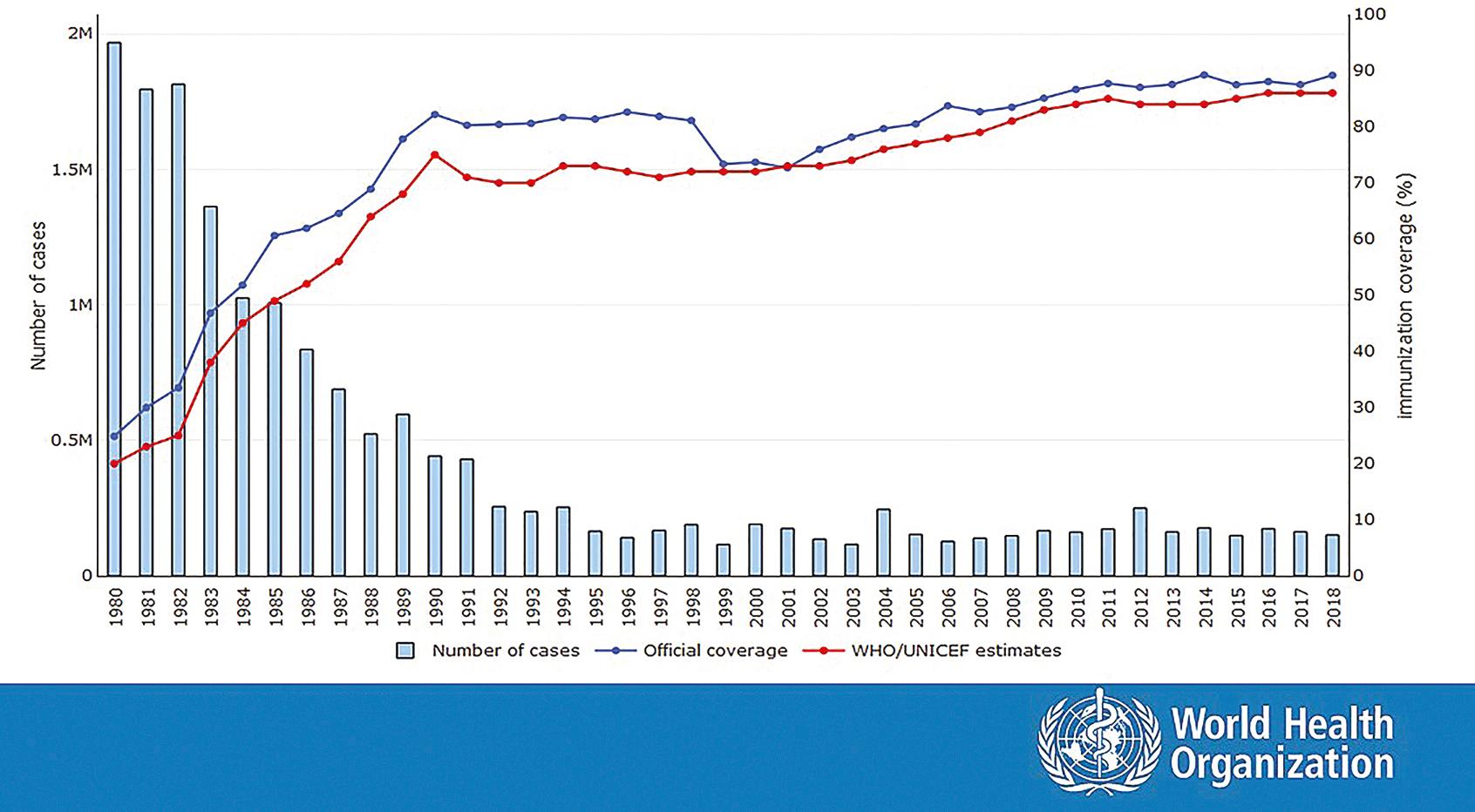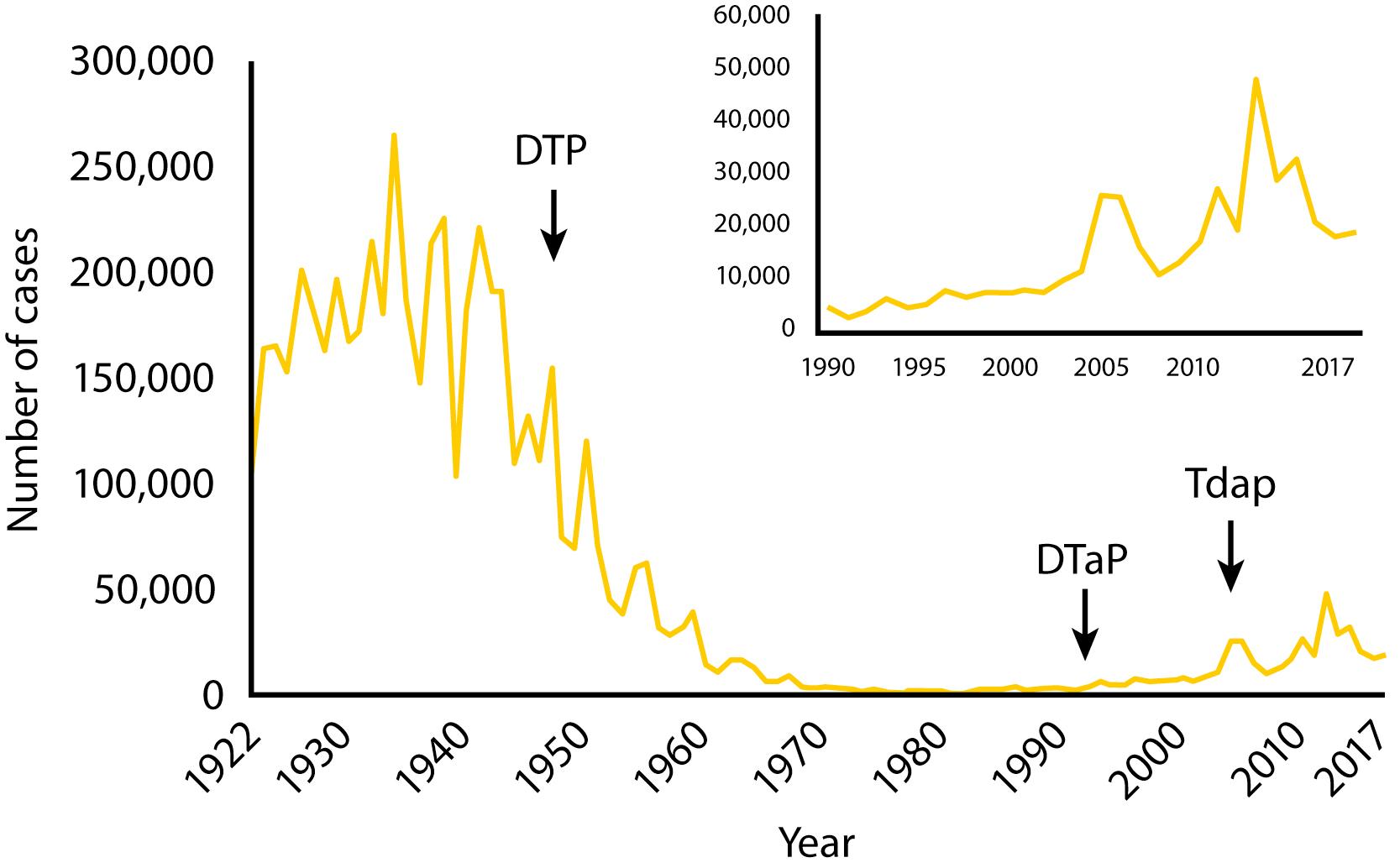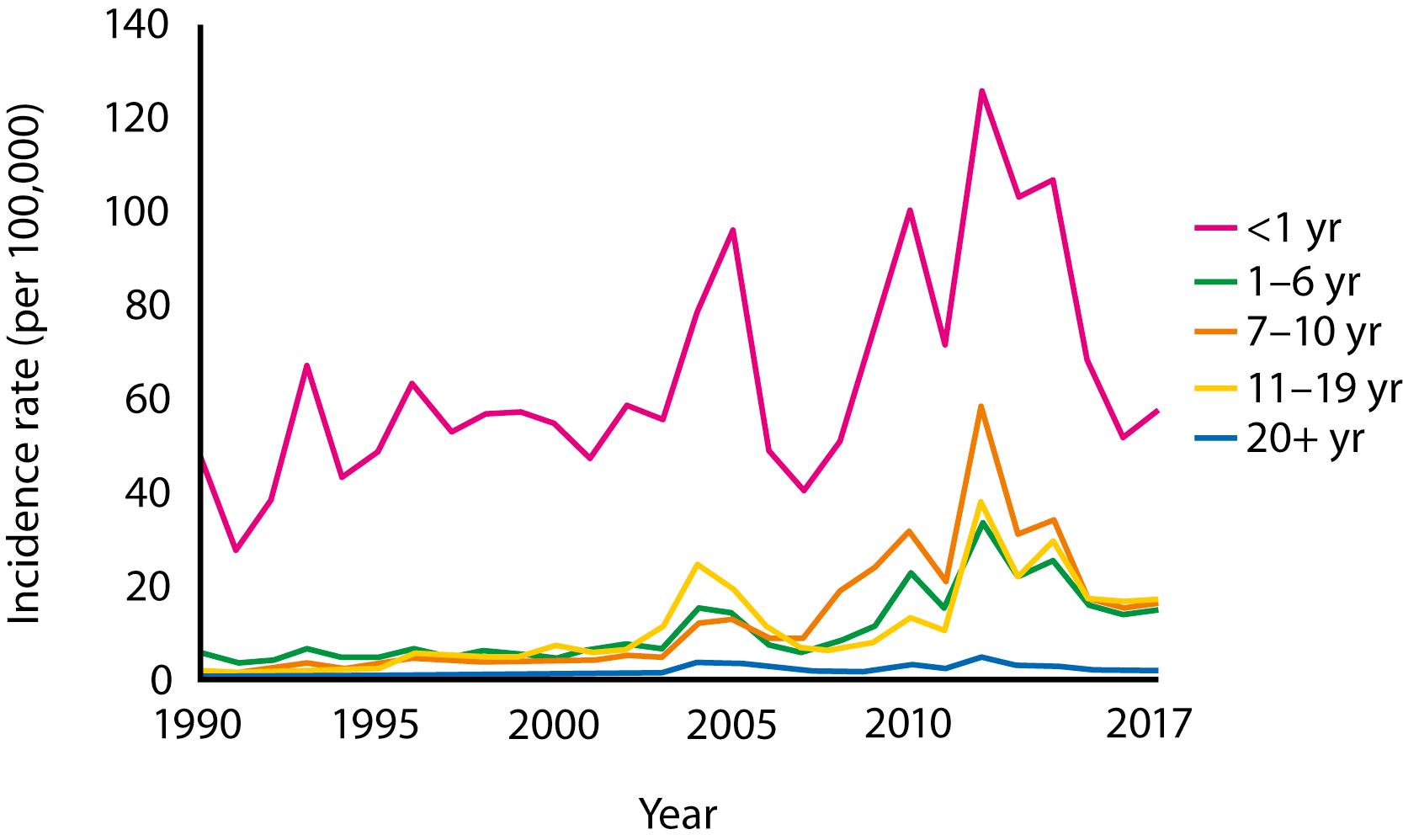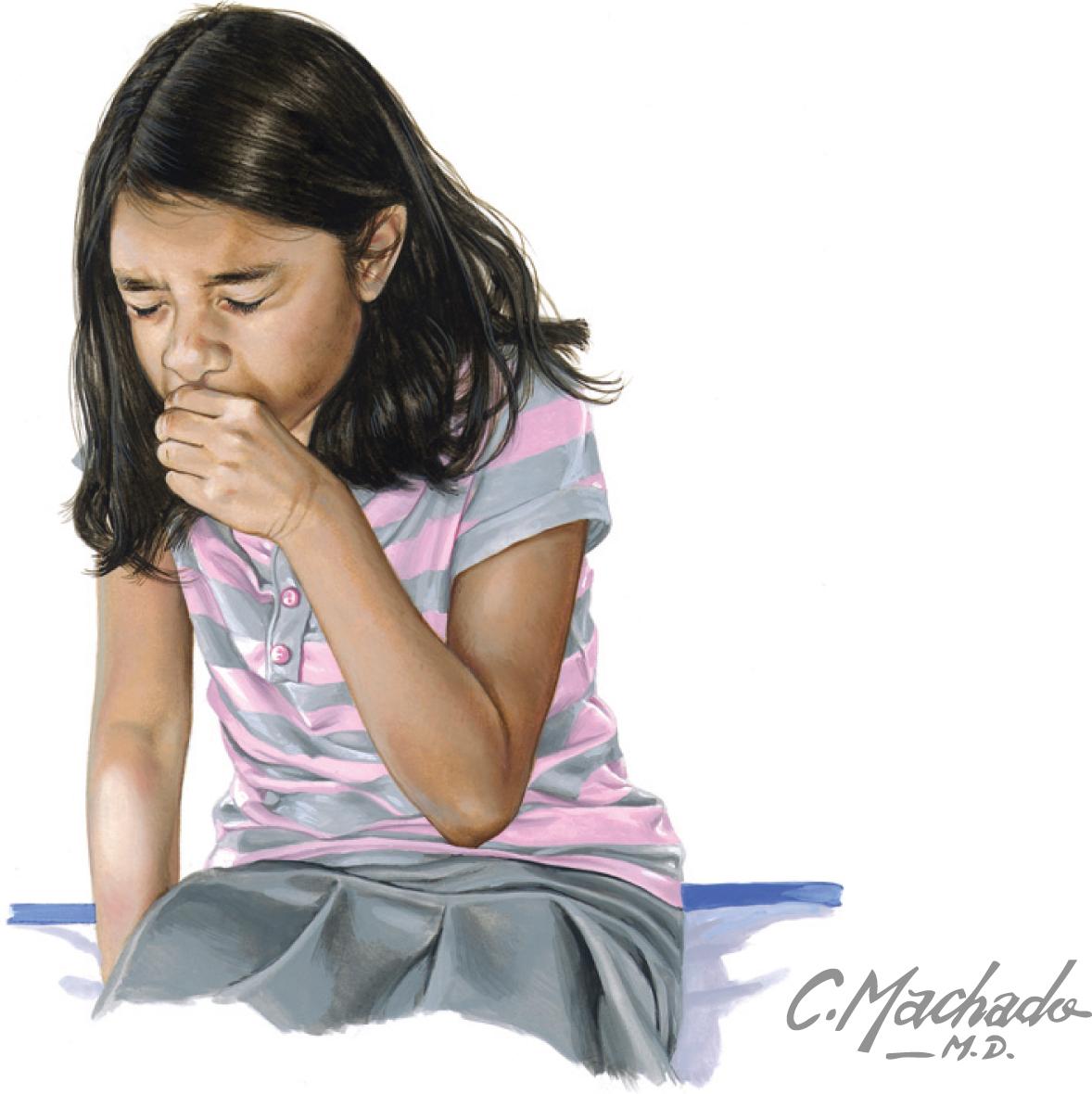Physical Address
304 North Cardinal St.
Dorchester Center, MA 02124
Despite the availability of vaccines against pertussis in most developed and developing countries, pertussis remains a significant cause of morbidity and mortality worldwide due to immunity following vaccination and clinical disease waning with time. Routine use of pertussis vaccines has shifted the burden of disease from middle childhood to young infants and older children, adolescents, and adults. The changing epidemiology dictates the need for new vaccines and new vaccine programs targeting these age groups.
A 9-year-old child presents with approximately 2 weeks of coughing. She reports that coughing comes on suddenly and has been increasingly forceful and prolonged, to the point where she feels she cannot breathe. She is anxious about going to sleep for fear of having a coughing fit. She is presently without rhinorrhea and has had no fever or other associated symptoms. There have been no ill contacts at home. Her immunizations are current, and there have been no new exposures to second-hand smoke, pets, or other allergens. There has been no travel outside the area she lives in. On exam, she is afebrile with normal vital signs. No abnormalities are noted on examination.
COMMENT: Due to changing pertussis epidemiology, children 7 to 10 years of age increasingly present with pertussis symptoms, presumably due to waning immunity from their last diphtheria toxoid and tetanus toxoid (DTaP) vaccination and before the recommended adolescent vaccination of tetanus toxoid and reduced-dose diphtheria toxoid (Tdap). Frequently, the illness progresses insidiously over time before it is recognizable as pertussis.
The World Health Organization (WHO) estimates, based on modeling data, that in 2014 worldwide there were 24.1 million pertussis cases and 167,000 deaths in children younger than 5 years of age. This is significantly greater than the 150,000 passively reported cases and approximately 80,000 to 90,000 annual deaths. Global vaccination coverage rate with three doses of pertussis vaccine stands at 86%. Pertussis is endemic globally, with epidemic peaks every 2 to 5 years. This cycling is unchanged even in the postvaccine era, likely because of both an accumulation of susceptible individuals, and in part a result of waning immunity.
Bordetella pertussis is strictly a human pathogen and is readily transmitted by aerosolized droplets. It is the primary cause of clinical whooping cough, with B. parapertussis, B. bronchiseptica , and B. holmseii creating a similar, although typically milder, spectrum of illness. The attack rate for susceptible individuals is estimated to be more than 80%. Globally, as vaccination coverage has increased, the overall disease burden has declined ( Fig. 3.1 ). In the United States, after the introduction of whole-cell pertussis vaccines in the 1940s, disease burden was the lowest in 1976 but has had a steady increase since 1980 ( Fig. 3.2 ). The incidence of disease has increased in infants, especially those too young to have completed the primary immunization series, and in adolescents and adults who experience waning immunity from either vaccination or natural exposure. In the mid-2000s, following the transition to acellular pertussis vaccine, there was an age-specific increase in pertussis clustering among those 7 to 10 years of age, presumably due to waning immunity from acellular pertussis vaccine ( Fig. 3.3 ). This was then followed by an increased disease burden among adolescents 13 to 14 years of age in 2012.



Infants younger than 12 months of age have the greatest risk of morbidity and mortality due to pertussis compared with all other age groups, with those younger than 2 months of age with the highest pertussis-related hospitalization and deaths. Studies from industrialized countries have reported rates of hospitalization because of pertussis ranging from 17 (6- to 11-month-old infants) to 280 (0- to 5-month-old infants) per 100,000 population. From 2004 to 2016, the Centers for Disease Control and Prevention (CDC) reports that among infants hospitalized for pertussis, 54.4% were younger than 2 months of age, and among infants who died, 85.5% were younger than 2 months of age. A study of pertussis deaths in the 1990s revealed a higher than expected rate of death in Hispanic infants and infants born at less than 37 weeks of gestation. Some preliminary data suggest this is due to limited maternal immunity in Hispanic mothers, and for preterm infants it is speculated that the cause is due to decreased placental transfer of maternal immunoglobulin G (IgG). Data suggest that administration of two to three doses of pertussis vaccine within the first 6 months of life is protective against severe disease. With the changes in pertussis epidemiology over time, mothers were originally the most common source of pertussis transmission to infants, whereas siblings are currently the most common source of pertussis infection for infants.
Since 2013, there have been reports of disease-causing strains of B. pertussis being deficient in a specific antigen, pertactin, which is one of the common antigenic targets of acellular pertussis vaccine. Subsequent vaccine efficacy studies suggest that the currently available acellular vaccines remain effective regardless of current circulating strains, even those deficient in pertactin. In addition, data do not suggest the pertactin-deficient strains differ in severity of disease compared with non–pertactin-deficient strains.
After exposure to the bacteria, the average incubation period is 7 to 10 days, which is then followed by onset of symptoms. The clinical illness is divided into three stages: catarrhal, paroxysmal, and convalescent.
The catarrhal stage appears similar to the “common cold,” with mild cough and coryza, and generally lasts 1 to 2 weeks. Fever is uncommon, and if present it is usually low grade. Unlike a common viral upper respiratory infection, which resolves quickly, in pertussis the cough gradually increases, and infected individuals are most contagious during this phase.
In the paroxysmal stage the coughing persists and gradually increases in severity, resulting in the classic paroxysmal attacks. Whooping may be observed during the paroxysmal phase, which is characterized by the noise of the forced inspiratory effort after the coughing attacks ( Fig. 3.4 ). Posttussive emesis may be observed. This stage may last 6 to 12 weeks and is the period in which complications are most likely to occur. The occurrence of complications is inversely related to age, with the youngest infants having the highest rate of complications. The most common complications include hospitalizations, apnea, pneumonia (primary and secondary), barotrauma events (e.g., subconjunctival hemorrhages, umbilical hernias, pneumothorax), and failure to thrive in infants who are unable to feed due to persistent coughing. Seizures, encephalopathy (likely related to generalized hypoxia), and death occur in less than 2% of patients and are generally seen in the youngest infants, although these events have been reported in adults. Pneumonia is the most common complication of pertussis (from either primary pertussis or secondary bacterial infection) and also the most common cause of pertussis-associated deaths. Infants younger than 4 months of age who died from pneumonia have been found to have histopathologic findings consistent with pulmonary hypertension.

During the convalescent stage the cough continues to decrease gradually over several weeks to months. Sporadic coughing paroxysms may reappear with subsequent upper respiratory infections during convalescence.
Infants younger than 6 months of age and previously immunized older children, adolescents, and adults are less likely to have the features of classic whooping cough. Young infants may have apnea as their only presenting feature, and a history of a coughing household member is often the diagnostic clue. Older children, teens, and adults may have chronic cough of varying severity as their primary sign. Persistent coughing has led to erroneous diagnoses such as asthma or reflux aspiration.
Become a Clinical Tree membership for Full access and enjoy Unlimited articles
If you are a member. Log in here